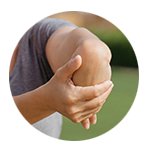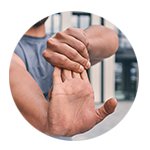6 ways to manage tennis elbow and golfer’s elbow


Many Canadians are deep into their favourite sports and recreational activities this summer. A common result of recreational sports is repetitive strain or injury due to overuse. Two of the most popular injuries that occur are tennis elbow and golfer’s elbow.
Even if you don’t play tennis or golf, these injuries can easily happen to you over time. Tennis elbow and golfer’s elbow are different types of injuries that both involve forearm muscles, but impact where the muscles connect to the joint on opposite sides of the elbow. They both relate to repetitive strain in the elbow and involve the wearing down of different tendons and the slowing of their ability to repair themselves.
What are the differences between Tennis Elbow and Golfer’s Elbow?
Tennis Elbow involves the muscles and tendons of your forearm that extend your wrist and fingers. Symptoms may develop gradually, with mild pain that slowly worsens over time. Tennis elbow usually doesn’t come from an injury, but rather from overuse of the tendons in your forearm.
Symptoms include – weak grip strength and a pain or burning sensation on the outer part of the elbow. Usually, they get worse when you use your forearm in activities like holding a racquet (hence “tennis” elbow), turning a wrench, or shaking hands.
Golfer’s Elbow involves the forearm muscles. In this case, we’re talking about the muscles that attach from the wrist and go to the “funny bone” area of the elbow near the inner bump. These muscles are responsible for wrist flexion and the twisting inward motion of the wrist, which explains its connection to golf.
Symptoms include – pain or tenderness near the funny bone, or inner bump of the elbow, as well as reduced strength in your grip. This type of injury can happen outside of sports activities: workers that regularly complete tasks that involve repetitive wrist flexion or “twisting” or forearm pronation (turning the palm downwards) commonly suffer from golfer’s elbow.
EXERCISES/STRETCHES
Luckily, there are some exercises and stretches applicable to both conditions that you can do to help manage your symptoms. Here are some options that can help with both tennis elbow and golfer’s elbow injuries:


For tennis elbow:
Hold your arm out in front of you, palm facing down, and pull your hand and fingers back towards you using your other hand. Do so gently so as not to cause pain. This shouldn’t be painful, so if it hurts, pull more gently for a slight stretch. This should stretch your forearm. Hold for 30 seconds, relax, and repeat three times.


For golfer’s elbow:
This exercise is similar to the one for tennis elbow, but the hand is inverted to the other direction. Hold your arm out in front of you, palm facing up, and gently pull your hand and fingers back towards your body using your other hand. Hold for 30 seconds, then relax. Repeat three times. You can do these stretches throughout your day.
ADDITIONAL EXERCISES
Wrist Extension: One of the common range of motion exercises for tennis elbow is wrist extension. Begin with your elbow at a 90-degree angle, palm facing down, resting on a table’s surface. Gently extend your wrist to lift it off the table (this should not be painful). Repeat ten times. As you progress you can add weight, like holding a water bottle, to add resistance and incorporate strengthening into the exercise.
Wrist Flexion: This exercise is similar to the wrist exercise above, but the palm is in the other direction. For the wrist flexion exercise, begin with your elbow at a 90-degree angle, palm facing up, resting on a table’s surface. Gently extend your wrist to lift it off the table towards the ceiling (this should not be painful). Repeat ten times. You can also add weight resistance to add strength training to the exercise.
Grip Strengthening: For this exercise, all you need is a squishy ball or “stress ball.” Hold the ball in your hand and gently squeeze. Hold for five seconds, relax, and repeat ten times. This exercise is helpful for both tennis elbow and golfer’s elbow.
Strength Exercise: One of the common strengthening exercises you can do is informally called the “hammer exercise.” You will need a hammer as your weight resistance. Hold the handle of the hammer, and keep your elbow at 90 degrees, rested flat on a table’s surface. Slowly rotate the hammer towards the centre of your body, turning the direction of your palm downwards. Then slowly reverse the motion, rotating the hammer outwards—your palm begins facing up with the heavy side of the hammer pulling on your arm. Rest briefly. Repeat ten times.
How a chiropractor can help
A chiropractor will work with you to diagnose and assess your injury, providing personalized stretches and exercises (which may include some of the stretches and exercises above) A chiropractor can provide treatments such as: manual therapy, acupuncture, laser or shockwave therapy, or a combination of treatments A chiropractor may be able to suggest specific compression or stability braces for your elbow
If you’re in Canada, suffering from an injury that is preventing you from playing tennis or golf, or if you would like to increase your mobility to improve your performance, a chiropractor can help.